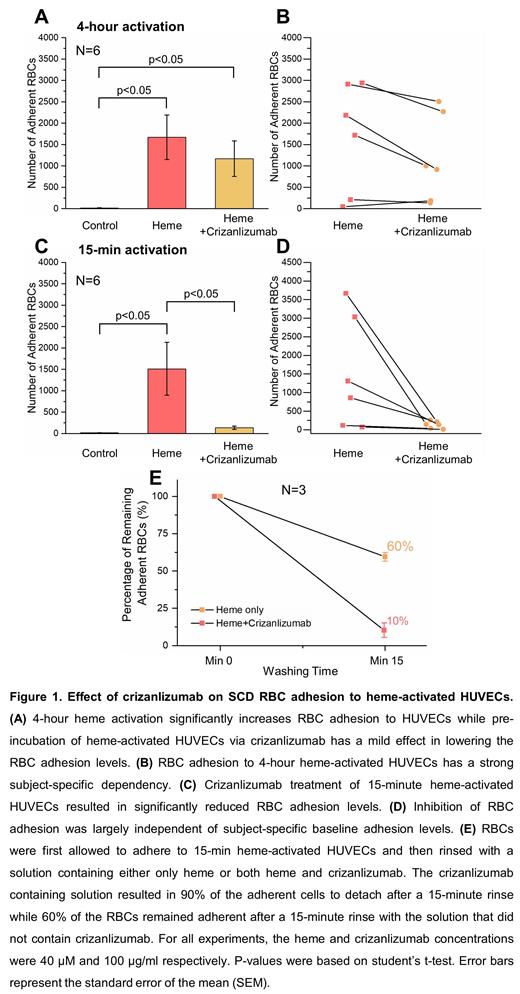Abstract
Background: Chronic upregulation of P-selectin (P-sel) on blood cells and the endothelium leads to abnormal red blood cell (RBC) adhesion to endothelial cells, significantly contributing to vaso-occlusive crises (VOCs), which are a major cause of morbidity and mortality in patients with sickle cell disease (SCD). Crizanlizumab (criz, a.k.a. SEG101) is a humanized anti-P-sel monoclonal antibody and has recently been approved by the Food and Drug Administration to reduce the frequency of VOCs in SCD patients. Here, we report in vitro assessment of the effect of criz on patient-specific RBC adhesion to heme-activated human endothelial cells using a standardized endothelialized microfluidic platform, the Endothelium-on-a-chip.
Methods: Whole blood samples were collected from 13 subjects with SCD (13 HbSS and 1 HbSC) in EDTA vacutainers. RBCs were isolated via centrifugation from whole blood and then resuspended in basal cell culture medium (EBM, Lonza, Morristown, USA) at a hematocrit of 20% buffered with 10 mM of HEPES. Human umbilical vein endothelial cells (HUVECs) were obtained from Lonza and cultured within the microfluidic channels at 15 dyne/cm 2 for at least 48 hours prior to experiments. For long-term activation, HUVECs were treated with 40 µM heme for 4 hours +/- 100 µg/ml criz for 1 hour followed by injection of blood samples through the microfluidic channels. For short-term activation, blood samples were supplemented with 40 µM heme +/- 100 µg/ml criz and injected through the microfluidic channels for 15 minutes. Thereafter, non-adherent RBCs were rinsed via either only heme-containing EGM or heme- and criz-containing EGM, and the remaining RBCs were quantified based on published methods [1]. Student's t-test was used to calculate statistical significance.
Results: We found that 4-hour heme activation of HUVECs resulted in significantly elevated RBC adhesion compared to baseline although adhesion levels were heterogenous among the patient population (Fig. 1A, 1671±522 vs 17±4, p<0.05). Treatment of 4-hour heme-activated HUVECs with criz did not significantly decrease RBC adhesion (Fig. 1A, 1170±413 vs 1671±522, p>0.05), while we observed lower RBC adhesion to criz treated HUVECs for certain subjects (Fig. 1B). By contrast, criz treatment significantly reduced the number of adherent RBCs to 15-min heme-activated HUVECs (Fig. 1C, 135±40 vs 1513±617, p<0.05). Next, we assessed whether criz would disrupt already established adhesive interactions between RBCs and 15-min heme-activated HUVECs. To do so, we first allowed RBCs to adhere to heme-activated HUVECs (for 15-min) and then rinsed the microchannels (at 10 μl/min) via either a heme- or both heme- and criz-containing solution (for 15 min). We then quantified the number of adherent RBCs at min=0 and min=15. While only 10% of the adherent RBCs remained in the microchannels following a 15-minute wash with criz, this ratio was 60% without criz (Fig. 1E).
Discussion: Our results show that the magnitude of inhibition of RBC adhesion to HUVECs with criz correlated with the duration of heme-activation (4 hours vs 15 minutes). This is likely due to variable levels of different adhesion molecules on acute or chronically activated HUVECs. For instance, it has been shown that P-selectin is rapidly translocated to the cell surface following heme activation [1], but its concentration on cell surface significantly decays with time. Previous experiments have shown that sickle RBCs can adhere to cell adhesion molecules such as ICAM-1 [2], which mechanistically may play a role in the case of a chronically activated endothelium. We are currently exploring whether criz would also reduce RBC adhesion to acutely activated endothelial cells that are under chronic stress. These preliminary results suggest that the Endothelium-on-a-chip, as partner in novel therapeutic studies, could help monitoring dynamics of targeted therapies in SCD patients during drug development and in clinical trials.
Acknowledgements: This work was funded by Novartis. The authors would like to thank the Ohio Third Frontier Technology Validation and Start-up Fund (TVSF) and National Science Foundation Phase-I Small Business Technology Transfer (STTR) award, which supported this work in part. Crizanlizumab was donated by Novartis.
References:
1. Kucukal, E., et al., American Journal of Hematology, 2018. 93(8): p.1050-60
2. Kucukal, E., et al., Blood Advances, 2020. 4(15):3688-98
Kucukal: BioChip Labs: Current Employment, Patents & Royalties. Kocevar: BioChip Labs: Current Employment. Nayak: BioChip Labs: Current Employment. Bruederle: Novartis Pharma AG: Current Employment. Zak: XaTek: Current Employment, Current holder of stock options in a privately-held company; BioChip Labs: Current Employment, Current holder of stock options in a privately-held company; TecTraum Inc: Current Employment, Current holder of stock options in a privately-held company. Gurkan: Dx Now Inc.: Patents & Royalties; Hemex Health, Inc.: Current Employment, Patents & Royalties; Biochip Labs: Patents & Royalties; Xatek Inc.: Patents & Royalties.


This feature is available to Subscribers Only
Sign In or Create an Account Close Modal